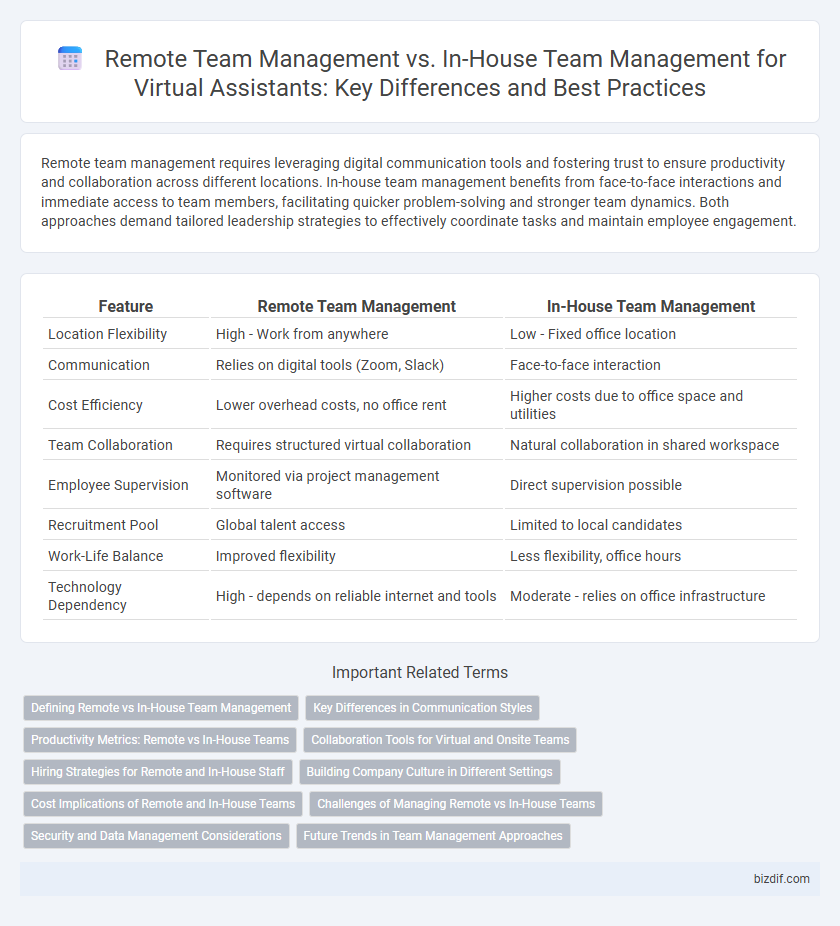Remote team management requires leveraging digital communication tools and fostering trust to ensure productivity and collaboration across different locations. In-house team management benefits from face-to-face interactions and immediate access to team members, facilitating quicker problem-solving and stronger team dynamics. Both approaches demand tailored leadership strategies to effectively coordinate tasks and maintain employee engagement.
Table of Comparison
| Feature | Remote Team Management | In-House Team Management |
|---|---|---|
| Location Flexibility | High - Work from anywhere | Low - Fixed office location |
| Communication | Relies on digital tools (Zoom, Slack) | Face-to-face interaction |
| Cost Efficiency | Lower overhead costs, no office rent | Higher costs due to office space and utilities |
| Team Collaboration | Requires structured virtual collaboration | Natural collaboration in shared workspace |
| Employee Supervision | Monitored via project management software | Direct supervision possible |
| Recruitment Pool | Global talent access | Limited to local candidates |
| Work-Life Balance | Improved flexibility | Less flexibility, office hours |
| Technology Dependency | High - depends on reliable internet and tools | Moderate - relies on office infrastructure |
Defining Remote vs In-House Team Management
Remote team management involves coordinating and supervising employees working from different geographical locations using digital tools and communication platforms, whereas in-house team management entails direct, face-to-face oversight within a shared physical workspace. Key differences include reliance on technology for remote teams to ensure collaboration, task tracking, and performance evaluation, while in-house teams benefit from immediate interaction and spontaneous problem-solving. Understanding these distinctions helps optimize leadership strategies tailored to each environment's operational dynamics and workforce engagement.
Key Differences in Communication Styles
Remote team management relies heavily on asynchronous communication tools like email, chat, and project management software, enhancing flexibility and documentation. In-house team management typically benefits from direct, face-to-face interactions that allow for immediate feedback and clearer nonverbal cues. Understanding these key differences in communication styles is crucial for optimizing productivity and collaboration in virtual assistant environments.
Productivity Metrics: Remote vs In-House Teams
Remote team management demonstrates higher productivity metrics due to flexible work hours and reduced commuting stress, leading to increased task completion rates and output quality. In-house team management benefits from direct supervision and immediate collaboration, which can improve real-time problem-solving efficiency and team cohesion. Analyzing productivity metrics reveals remote teams excel in individual performance and autonomy, while in-house teams show strengths in collective engagement and synchronous workflows.
Collaboration Tools for Virtual and Onsite Teams
Collaboration tools for virtual and onsite teams enhance communication, project tracking, and real-time feedback, streamlining remote team management. Platforms like Slack, Trello, and Microsoft Teams enable seamless interaction and task coordination across different locations. These tools support time zone flexibility and reduce miscommunication, boosting productivity in both remote and in-house environments.
Hiring Strategies for Remote and In-House Staff
Effective hiring strategies for remote and in-house teams differ significantly in candidate evaluation and onboarding processes. Remote team management prioritizes digital communication skills, self-motivation, and cultural fit across diverse locations, leveraging virtual assessment tools and flexible scheduling. In-house hiring strategies focus on direct interpersonal interactions, physical presence, and team cohesion within the workspace, often involving face-to-face interviews and on-site training sessions.
Building Company Culture in Different Settings
Building company culture in remote team management relies heavily on intentional communication strategies, virtual team-building activities, and fostering a sense of trust through regular video interactions. In-house team management benefits from face-to-face engagement, spontaneous collaboration, and shared physical workspace, which naturally enhance team cohesion and cultural values. Integrating digital tools that promote transparency and acknowledgment helps unify company culture regardless of the team's physical location.
Cost Implications of Remote and In-House Teams
Remote team management significantly reduces overhead costs such as office space, utilities, and commuting expenses compared to in-house teams. In-house team management often entails higher fixed costs due to infrastructure and on-site resource allocation. Virtual assistants enable businesses to optimize operational budgets by leveraging remote talent with flexible cost structures tailored to project demands.
Challenges of Managing Remote vs In-House Teams
Managing remote teams presents challenges such as maintaining clear communication, fostering team cohesion, and ensuring accountability without physical oversight, unlike in-house teams where direct interaction simplifies these aspects. Remote management relies heavily on digital tools to track progress and address issues promptly, while in-house teams benefit from immediate feedback loops and easier conflict resolution. Ensuring consistent productivity and engagement requires structured workflows and trust-building practices tailored to the remote environment.
Security and Data Management Considerations
Remote team management demands robust cybersecurity measures such as encrypted communication channels and secure cloud-based data storage to protect sensitive information effectively. In-house team management allows for more direct control over physical access to data servers and easier implementation of internal security protocols. Both models require comprehensive data privacy policies and regular security audits to mitigate risks and ensure compliance with regulations like GDPR and HIPAA.
Future Trends in Team Management Approaches
Future trends in team management emphasize a growing shift towards hybrid models that combine remote and in-house team dynamics. Advanced AI-driven virtual assistants are enhancing collaboration by automating task allocation, performance monitoring, and seamless communication across diverse locations. Data from Gartner predicts that by 2026, 75% of organizations will adopt AI-enabled tools to optimize both remote and in-house team productivity.
remote team management vs in-house team management Infographic

 bizdif.com
bizdif.com